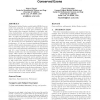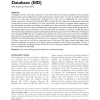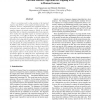758 search results - page 3 / 152 » Coding Exon Detection Using Comparative Sequences |
RECOMB
2004
Springer
14 years 10 months ago
2004
Springer
Phylogenetic hidden Markov models (phylo-HMMs) have recently been proposed as a means for addressing a multispecies version of the ab initio gene prediction problem. These models ...
BMCBI
2006
13 years 9 months ago
2006
Background: ESTs are a tremendous resource for determining the exon-intron structures of genes, but even extensive EST sequencing tends to leave many exons and genes untouched. Ge...
BIB
2006
13 years 9 months ago
2006
Investigation of exon^intron gene structures is a non-trivial task due to enormous expansions of the eukaryotic genomes, great variety of gene forms, and the imperfectness in sequ...
CSB
2002
IEEE
14 years 2 months ago
2002
IEEE
There is a pressing need to align growing set of expressed sequence tags (ESTs) to newly sequenced human genome. The problem is, however, complicated by the exon/intron structure ...
CSB
2003
IEEE
14 years 3 months ago
2003
IEEE
The problem addressed by this paper is accurate and automatic gene annotation following precise identification/annotation of exon and intron boundaries of biologically verified ...



